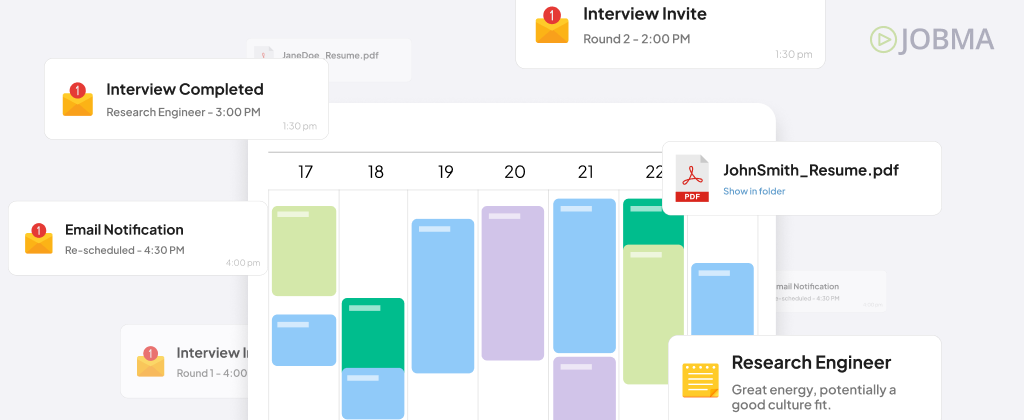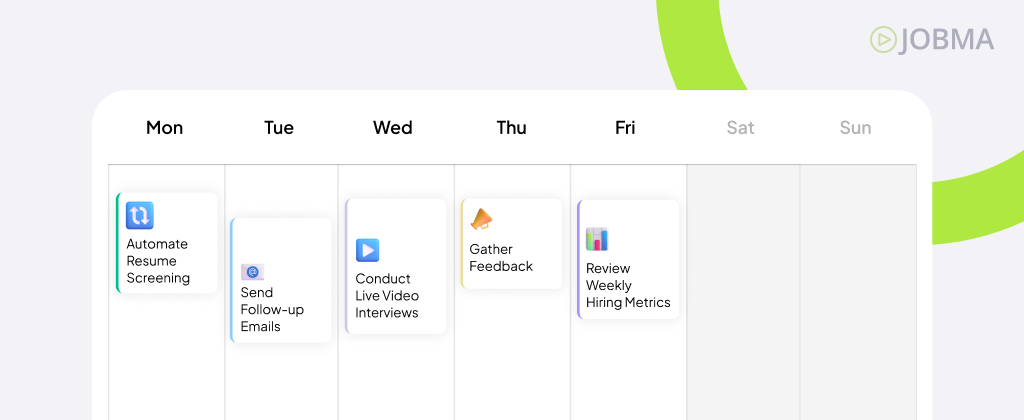Stretching Smarter: How HR Teams Can Stay Agile and Avoid Burnout in Recruitment
Yoga is widely recognized for its ability to improve flexibility, restore balance, and promote inner peace. But it isn’t limited to physical wellness, it also teaches valuable lessons about agility, mindfulness, and balance in life and work.
Applying these principles of yoga to your HR team and your recruitment process, just as yoga helps you stretch and avoid unnecessary strain, can similarly ease stress, increase efficiency, and prevent burnout in the recruitment process.
This blog will help you understand how smart recruiting tools and mindful habits can boost your HR team’s productivity.
The Essence of Stretching Smarter
Smart hiring means accomplishing more through focused effort. It’s the art of becoming flexible and agile without overloading your resources or your team. If you’ve opened a new role lately, you know the flood: 250 resumes in a day, most of them off-target. Securing interview times adds to “calendar chaos” as recruiters chase busy managers and candidates through endless email threads.
The notes end up in three places: spreadsheets, email chains, and e-sigs, so you spend lunch just copying and pasting.

When candidates don’t hear from you, they’re possibly going to swipe right on another offer. This constant context-switching keeps you in perpetual catch-up mode, accelerating burnout and turnover within the function.
However, this doesn’t have to be your reality. Just as yoga helps your body handle stress better by improving flexibility and balance, adopting smarter recruitment practices will make your hiring team’s workload manageable and efficient.
How Yoga Principles Apply to Recruitment
Treat your recruitment strategy through the lens of yoga’s three fundamentals: flexibility, balance, and mindfulness.

Flexibility in Recruitment
Flexibility in recruitment means adapting swiftly to new hiring demands or unexpected challenges without causing stress or chaos. Let modern screening software sort the resumes for you. Filter through applications, identifying qualified candidates based on set criteria and quickly discarding those that don’t fit. With automation, your team will not feel strained by tedious tasks.
Automated screening lifts hiring quality by matching each resume to the skills and habits of your best employees. By handling routine tasks efficiently, you free up your HR team to focus on more strategic and creative responsibilities.
Balance to Prevent HR Burnout
HR burnout is a real challenge that seriously impacts your team’s performance and morale. To prevent this, it’s important to ensure your recruitment processes are balanced and tasks are evenly distributed. This helps keep the workload manageable and your team energized.
An interview management platform like Jobma syncs with Google or Outlook calendars to surface only conflict-free slots, lets candidates pick, or instantly reschedule on their own time, and fires automatic reminders so no one forgets to show up.
As soon as a call ends, structured scorecards pop up for interviewers, nudging them to rate skills against a shared rubric instead of dashed-off notes in an email. All feedback flows into one dashboard, where you can see at a glance who’s late with a scorecard, which candidates are stuck in a loop, and how many hours each stage is taking.
For example, platforms like Greenhouse and GoodTime allow candidates to self-schedule interviews based on real-time availability, while recruiters can automate reminders and collect structured feedback using customizable scorecards. Tools like Jobma support asynchronous video interviews, making it easier to evaluate candidates across time zones. By integrating with your ATS and calendar tools, these systems reduce administrative load and free up your team to focus on what matters: making great hires.
Mindfulness in Candidate Interaction
Mindfulness in yoga means paying attention, staying present, and thoughtfully interacting with each moment. In recruitment, mindfulness translates to focusing fully on candidates, their experience, and how each interaction reflects on your organization’s culture.
With a video interviewing software like Jobma, you send candidates a structured set of questions that they can answer whenever they’re focused, avoiding time-zone gymnastics for everyone. Every video reply is saved in high quality with transcriptions, ready for you and your team to review at any time. The result: calmer interviews, fairer evaluations, and decisions made on thoughtful evidence rather than hurried notes.

Practical Steps to Stretch Smarter in Recruitment
Let’s explore practical ways to implement these yoga-inspired principles into your recruitment strategy.
1. Automate Smartly but Thoughtfully
Automation should amplify your team’s human touch, not replace it. Modern hiring tools allow you to go beyond simple resume filters. These tools not only benchmark candidates against top performers, but they can also provide useful insights into cultural fit and push everything straight to your ATS and calendar. That cuts clerical drag, speeds up scheduling, and delivers a data-backed shortlist you can defend with confidence.
By delegating the initial screening to automation, your HR professionals spend more time on strategic interviewing, candidate relationship-building, and improving recruitment processes.
2. Simplify Scheduling and Feedback with an Interview Management System
A chaotic schedule is a recipe for burnout. A central interview management system streamlines scheduling, feedback, and follow-ups. By providing a centralized hub where interviewers can see real-time updates, your team eliminates confusion and reduces the possibility of mistakes or duplicated efforts.
HR professionals who use interview management systems typically report a noticeable reduction in administrative stress, better communication, and increased satisfaction both internally and from candidates.
3. Incorporate Video Interviews for Flexibility and Better Decision-Making
In-person interviews offer deep insights, though they naturally call for more time, budget, and coordination. Video interviewing software gives you flexibility by eliminating geographic and scheduling constraints, allowing more candidates to participate conveniently.
Candidates join from anywhere, at any time, while built-in AI transcribes, scores, and summarizes each response against role-specific benchmarks. Recruiters get a data-driven shortlist instead of gut feeling, hiring managers review clips on their schedule, and the company trims travel spend and time-to-hire, without sacrificing the human touch.
HR teams can review recorded video interviews at their convenience, get AI insights to augment their decision-making, and ensure evaluations are unbiased and thoughtful. This ensures your team remains balanced, mindful, and able to make informed and data-backed hiring decisions consistently.
Cultivating HR Wellness to Avoid Burnout
Yoga emphasizes holistic wellness, body, mind, and spirit. Similarly, an effective HR team must prioritize wellness to perform at its best. Here’s how your team can incorporate wellness practices inspired by yoga:
1. Introduce Short Daily Wellness Breaks
Take five to ten minutes daily for simple or mindfulness exercises. Yoga poses at your desk, like gentle neck stretches or seated spinal twists, can significantly relieve tension and improve focus.
2. Regular Wellness Workshops
Monthly yoga or mindfulness workshops encourage your team to prioritize wellness as an essential part of their professional lives. Studies show that wellness initiatives can significantly reduce workplace stress, increase productivity, and boost employee morale.
3. Promote Mindful Work Habits
Encourage your HR team to set boundaries, like designated email-checking times and clear work schedules. Mindful work practices can drastically reduce burnout, improve productivity, and boost overall satisfaction.
A Balanced Recruitment Week Example
This balanced weekly routine can ease your stress. You may need to adjust it based on your workflow, team capacity, and existing hiring strategy.

Monday: Kick-start the week with proactive sourcing and automated resume screening using candidate-screening software, launch outreach messages, and shortlist candidates for the next stage.
Tuesday: Send follow-up emails to sourced prospects and schedule all initial video interviews through your interview-management system so your team can review and evaluate these flexibly and calmly.
Wednesday: Conduct live video interviews, nurture any silent prospects with role highlights between calls, and coordinate smoothly without scheduling stress, remember short mindfulness breaks.
Thursday: Gather team feedback through your centralized interview-management system, hold a quick decision huddle, run a second-wave sourcing burst to fill any gaps, and decide who progresses without confusion.
Friday: Draft offers for finalists, send courteous rejections, pull weekly hiring metrics, host a team wellness session with short yoga, share reflections on the week, and plan calmly for the next one.
Measure Your Success
Measure how well your smart hiring works by tracking these key metrics:
- Time-to-Hire: Let your ATS mark the dates for each step (application → screen → interview → offer) so a simple dashboard can show the average number of days. Pick a friendly target, say three weeks, and chip away at it with small helpers like auto-scheduling links or e-signatures rather than big overhauls.
- Team wellness: Slip a one-question pulse poll into your Friday wrap-up (“How was your stress level this week?”). Glance at the trend line and, if it drifts upward, chat privately with the team to rebalance workloads or add a meeting-free afternoon.
- Candidate experience: After each stage, send a two-click survey asking about clarity and communication. Review the responses once a month, share the highlights with hiring managers, and tweak anything obvious, shorter instructions, and clearer subject lines, before the next cycle.
- Track your recruitment sprint progress with a visual burndown chart. So you can use this free burndown chart generator to plot your hiring pipeline against time. See how many candidate interviews you complete daily versus your sprint goals
These light-touch checks keep you informed without piling extra work onto an already busy week.
Conclusion
In the spirit of yoga, it’s time for your HR team to embrace the concept of stretching smarter, building flexibility, balance, and mindfulness in your recruitment process. Organizing interviews in one system helps your team work more efficiently, move faster, and stay focused on finding the right fit.
When paired with mindful wellness habits, these tools help HR teams make better hiring decisions while keeping people at the center. Smart hiring isn’t about doing more, it’s about doing better, feeling better, and ultimately achieving more meaningful outcomes with less stress.




